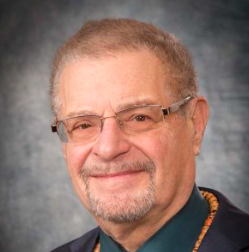About the Author:
 Dr. Kenneth Byalin, Roshi is the President of ICS and has broad experience in organizational leadership and education, as well as social work.
Dr. Kenneth Byalin, Roshi is the President of ICS and has broad experience in organizational leadership and education, as well as social work.
With nine years of experience as the leader of LPCS and NVCS, he is also the President and Founder of the Verrazano Foundation, a member of the Zen Peacemakers for over 25 years, and was previously the Chief of Service at South Beach Psychiatric Service for 18 years. He holds a Ph.D. in Sociology from NYU, a MS in Social Work from Columbia University, and a BA in English from Carleton College.
In the following article, Ken Byalin reflects on the relationship of his Zen training and heading an education establishment for children of special needs.
STATEN ISLAND, NEW YORK, USA. When I was in my junior or senior year of high school, I read an article about Carleton College, probably sent to me by Carleton, in Look (a now-defunct competitor and alternative to Life, which is pretty much defunct now too.) It described the college as a co-ed monastery. I was intrigued by the image without any articulation of why the image grabbed me. It clinched my intention to go to Carleton.
Magically, Carleton was the only college that accepted me.
This was the same period in my life when I first discovered Zen in a suburban bookstore, long ago when mom and pop bookstores were pretty much the only place in which one could buy books.
While working on an English writing assignment, I had gone to the bookstore in search of a book about haikus. I found the only one, and next to it was a little intro to Zen by D.T. Suzuki. I bought them both.
I still have the book.
I was fascinated, enchanted. Somehow in these books, I found a glimpse of personal peace which drew me. The image, the picture in my mind, was of the rural Zen monastery, a picture in brown and tan tones. I had in mind a large oil painting of my father’s hanging in our living room, a rural landscape in arid colors dotted with small figures in black, a few small buildings and my father’s ersatz Chinese calligraphy.
He had been intrigued as many of his artistic heroes had been by Chinese and Japanese art and briefly painted in this style.
This is my image of the Zen monastery.
As a Zen teacher, I have struggled with a dichotomy in my practice —on the one hand leading a Zen group on Staten Island, my traditional Zen teaching practice, and then the work of building our family of schools. While I have always known that my work as a Zen teacher was primarily within the school building, I have felt a tension.
Sometime in the last year, the realization began to take shape that the monastery in my mind was being realized in the schools.
We have been building a school culture which is breaking down the barrier between work and family. This is subtle.
Perhaps our awareness of what we are doing began when we realized that many of our best new staff members were relatives of current staff members. I said for the first time at a meeting of the Bucks Business Network, during a discussion of the challenges of family-owned businesses, that we too were a “family business.” We just were not all members of the same family.
Then we realized that if we were going to work together for many years, all of us were going to go through all the challenges that families go through. We began to say “Families first.” We are an extended family. We will support each other through the family crises we will all inevitably face. That’s what families do.
As we began to articulate our values, we saw an underlying bond of shared values.
A couple of years ago, we began to talk about succession planning. Early on, we realized that we wanted my successor to come from within our organization rather than from the outside. Our rising leaders wanted to know exactly what it is that I do and how did I learn to do what I do.
As we worked on answering these questions, I, of course, shared that my Zen practice had been an absolutely crucial piece of my evolution, both professionally and personally. In the marrow of Bernie’s Zen is the awareness that one’s spiritual practice does not have to be Zen or Buddhism. But it does need to be a practice that contains deep elements of self-awareness and of awareness way beyond.
We have talked about it in our succession planning sessions and we have found this idea to be resonating in Peter Senge’s Fifth Discipline and in Ray Dalio’s Principles.
We left it at that.
I had no real evidence that any of our young leaders were doing anything with this information. A tension arose for me. On the one hand, it felt wildly intrusive for me to bring my Zen practice into the school. (As part of our Wellness curriculum, we teach students mindfulness. We don’t teach Zen). If anyone on the staff was truly interested, they could join our Zen meditation group at Wagner College where I nominally served as the Buddhist Chaplin.
On the other hand, I could see our young leaders struggling with their conditioning. How to teach them? The only help I had to offer was through Zen practice.
Then two things happened.
We began to design a new school facility that would house three of our four divisions and provide special facilities for our entire network. One exciting element in the design was a staff Yoga and Meditation Studio where classes would be offered throughout the week and which would be available at other times to all staff members seeking a sanctuary from the pressures of our work. Progressive, yet needed. And welcomed.
And then, things began to change at Wagner College. Key staff members were leaving, and from the outside, it appeared that many things were changing.
When we had originally moved the Zen group to Wagner from the Catholic retreat center where our multi-faith meditation group began, the college was eager to have us. It was part of their effort to create a welcoming environment for students of all faiths —many of whom would be far from home and family perhaps for the first time in their lives.
Yet recently, the campus spiritual center where we met for meditation had been booked simultaneously for very intense (and loud) discussion groups which made quiet contemplation impossible. It was apparently time again for our Zen group to move on.
At this moment, we have only just begun offering meditation for staff at our school, moving the Zen group from Wagner to our building and adding a second sitting opportunity to accommodate differing staff schedules. We do not know yet if these will take root at ICS. Who will sit? And how will they grow?
The Chinese Zen monastery in my mind (and I think in Bernie’s) was built around working, and living together.). One does not learn Zen from a teacher by listening to his words (although unfortunately, that is largely the way of American Zen teaching). In our tradition, we learn Zen by sharing the teacher’s day-in and day-out practice. There is no backstage; warts are not hidden off stage. Whatever I have to teach is best taught by sharing more of my life than is available in a weekly meditation group. How do you learn what I have to teach and then make it your own? My answer, of course, includes the meditation practice through which you shed your conditioning, thus emptying yourself, allowing a new way of being the space to enter.
What possibilities open up as the gap between my traditional Zen teaching practice and my organization building work at schools decreases? Are we now building the monastery in my mind? It seems mystical to me.
We are building a monastery without walls, built around shared mission and values, without the restricting orthodoxy which has characterized traditional monastic communities.
How could my father have painted this image so clearly and so many years ago?
The is a repost from The Integrative Charter School’s blog. To read and learn more about the Integrative Charter Schools in Staten Island, New York, USA you may do so HERE.

